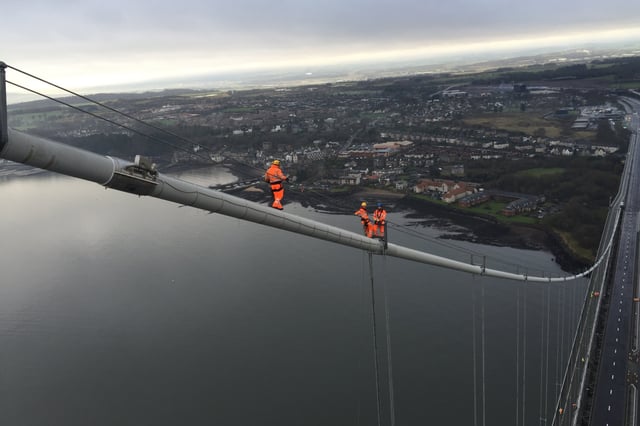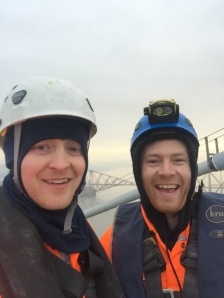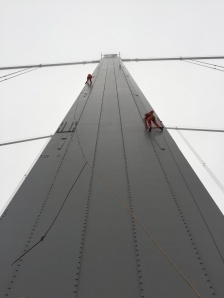Does this photo not say it all? As rope technicians, your workplace can include some pretty incredible perspectives that no one else will have the opportunity to witness.
This photo here, courtesy of Robert Meechan, is a picture of the closure of the Forth Road Bridge in Scotland. We found out about this historical road closure rather arbitrarily on LinkedIn through an incredible photo share, which illustrates one of the many abilities of Rope Access.
This photo rocked our social media community and with some quick research to locate the photographer, I was able to connect with Robert Meechan, a Rope Access tech who was one of the supervisors on this visually infamous structure. Robert was willing to share some insight on his experience working on this site and being an active Rope Access tech within the UK. Speaking with techs who work outside of Vancouver, Canada remains one of my favorite resources for creating these blog entries and this story is certainly no exception. In fact, it’s one of my favorites to date because it speaks of the way in which Rope Access can accomplish not just incredible access but more profoundly assists in preserving material history in many cities across the globe.
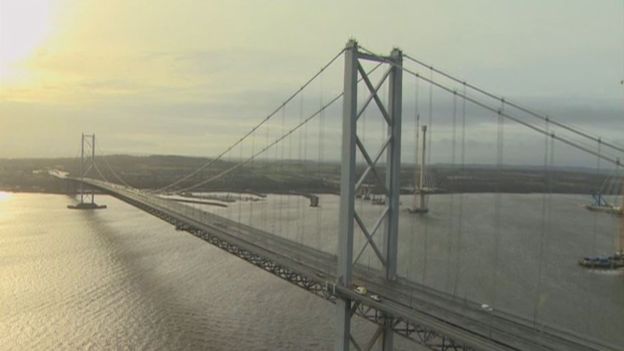
Before we dive into Robert's interview, here's a bit of background on the bridge. In 1964, the Forth Road Bridge was the longest steel suspension bridge in Europe, built in East Central Scotland. The bridge spans the Firth of Forth, connecting Edinburgh, at Queensferry, to Fife, at North Queensferry, and is considered a primary traffic artery for most people in transit there. The bridge replaced a centuries-old ferry service to carry vehicular traffic, cyclists, and pedestrians across the Forth and later a convenient rail crossing was build adjacent to it named the historic Forth Bridge.
It is with some sentimentality that the Forth Road Bridge will always symbolically represent a time when Scotland’s economy was once inextricably tied to the steel and iron industry as it once employed almost half of the Nation's working population. However, after a long history of economically responding to British sectoral control and the ultimate British privatization of the steel industry in 1988 (in combination with high manufacturing costs, a downturn in shipbuilding, the aggressiveness of free market principles and overseas competition), Scotland fatefully lost its grip on its fiercest economic generator. After 150 years in operation, Scotland saw its last standing steel and iron manufacturing plant close its doors in 2015 with little hope of ever reopening (See HeraldScotland Article for more detail). To date, the Forth Road Bridge represents so much more than the utility of transport; it stands as the historical might of the Scottish people and their fortuitous contribution to the Nation’s once great iron and steel industry.
On 4 December 2015, the bridge was closed to all vehicular traffic, pedestrians and cyclists due to structural issues.
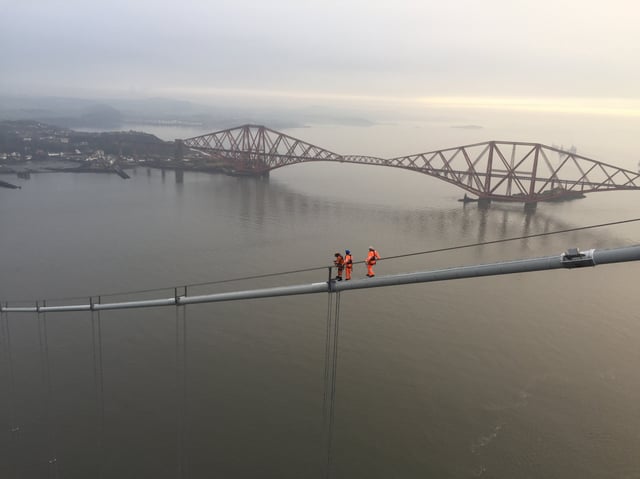
Engineer, Mark Arndt, from maintenance contractor Amey, told National media he had been faced with an "unprecedented set of circumstances" when he inspected the condition of the bridge in December 2015, the least of which was the ongoing corrosion of the suspension steel cables. Mr. Arndt was concerned that a similar damage could appear on the other side of the tower support leading to more damage and safety implications. "As shear failures happen quickly and unpredictably we were left with no alternative but recommend the bridge be closed," he said.
"It is an unprecedented set of circumstances that we faced here. Independent opinion was sought throughout the process. It is a complex engineering challenge at a very difficult to access location."
More than 70,000 vehicles are driven across it every day and around 24 million each year. It is one of Scotland’s life-giving arteries, maintaining the circulation of its commerce and commuting the weight of its people.
So, as is now more commonly the case, Rope Access technicians and skilled tradespeople were contacted to complete this job and accomplish the level of complex access and assessment that had to take place. Rope Access undeniably shines as a method of access in a case like this and with bridge work more holistically. The Forth Road Bridge reconstruction project continues to shine a light on the success and innovation of our industry, and there is no telling how many more instances Rope Access technicians will be called into action on this site again.
So, for a more personal take on the experience of working on this site, here is my brief interview with Robert Meechan. Keep in mind Robert does not represent the experience of all the techs that contributed to this project.
How did you get your start in Rope Access? And, how long have you been practicing Rope Access in the UK?
I left school at 16 and went into steeple jacking as a good friend of mine saw the potential in me. He is an older friend and works non-stop if he can— ha! The same as myself now.
I gained my Level 3 Rope Access certificate at the age of 21. I was one of the youngest people in IRATA to gain this qualification at the time. I was almost denied my certification as the industry was still a bit tight at that time- I needed to know someone etc, but I gained my Level 3 with an excellent pass on my certificate. Now it seems a bit ruined with guys wanting to gain their Level 1 just to pass the 2 years experience and 2000 hours to become a Level 3. Enough ranting from me lol.
How was your experience working on the Forth Road Bridge?
My experience on the Forth Road Bridge was what I expected to be honest. Too many chiefs… too many people making things over complicated or over thinking situations, making things complex. Keep it safe and simple is my moto. Then everyone understands the task, rescue and rigging etc. needed to do the job right and effectively.
As a supervisor on that site, what was your greatest challenge?
As being a supervisor the biggest challenge was getting good enough weather to rig ropes and rescue equipment. Also to carry out our task in hand.
If you sit back and consider the great successes of that job, what stands out for you in particular?
The job I was given for my team to carry out was done safely, no incidents or accidents and it was completed before the scheduled time allocated. That always a success in the eyes of our contractors and as a team.
Has this been one of the most exciting work sites of your career?
It's not been the most exciting work sites of my career but it was a good one. Good Rope Access work and a decent enough height.
How many of you in total worked on site?
There was roughly 65 abseilers on the site. Give or take a few.
What trade work was completed at height?
The trade work that was completed at height was NDT inspections and rigging work
In general, what keeps you passionate about Rope Access work?
I am passionate about Rope Access as all my tasks are different- no 2 tasks are the same. Also, I love working at height. For me, the higher the better!
Where do you see the industry heading in the future?
The industry in the UK is flooded just now with many people interested in doing their Rope Access certificartion to gain work. Some don’t see to have a passion or drive behind them and that’s a shame really as Rope Access is amazing.
To end on a high note, what has been your all-time favorite site to work on?
The most exciting jobs I have been involved in were from changing out several sheaves out in Norway offshore, blasting and spraying the jacket on the Elgin Franklin oil rig offshore off of Aberdeen, changing out the air craft warning lights on telecoms towers throughout Scotland and England.
Working on the Forth Road Bridge was a decent job, but would have been better if the weather allowed us access all the time.
It was really awesome to chat about Robert's experience working on the Forth Road bridge. Rope Access has so many capabilities to accomplish difficult access work, which always means for an exciting career as a Rope Access Technician anywhere in the world!
To find out more about how to become a rope tech, click below!
